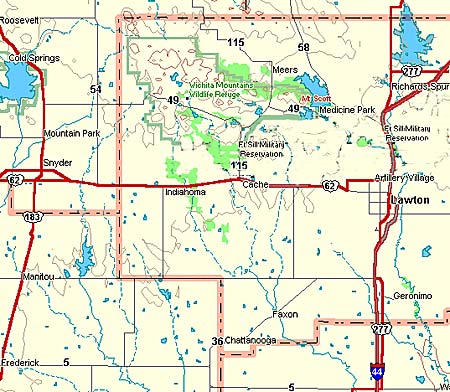
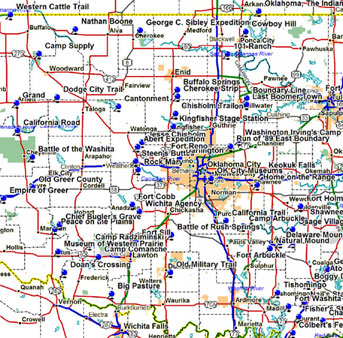
Click map to enlarge view of Western Oklahoma
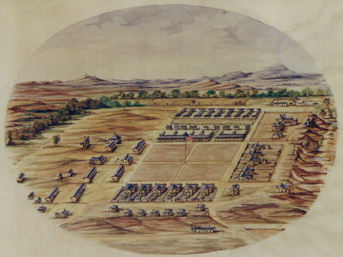
Picture from the Fort Sill National Historic Landmark And Museum Web Site

Picture from the Fort Sill National Historic Landmark And Museum Web Site
Museum Directions
From Interstate 44, take exit 41 (Key Gate) and turn west
on Sheridan Road. Turn right onto Randolph Road and drive .6 mile. Turn
right onto Chickasha Road, them immediately left onto Quanah Road. The
museum visitors' center is Building 435 on your left. The second building
on your left, B437, is the museum administrative office.
From Lawton, follow Fort Sill Boulevard northbound onto
Fort Sill. Turn right at the stop light onto Sheridan Road, eastbound.
Turn left at the stop light onto Geronimo Road, northbound. Cross Randolph
Road and turn right on Quanah Road. The third building on your right
is the museum center, 435 Quanah Road.
Hours
Admission to the Fort Sill Museum is free and open to
the public Tuesday through Saturday, 8:30 a.m. to 5:00 p.m. We are closed on Sunday and
Monday.
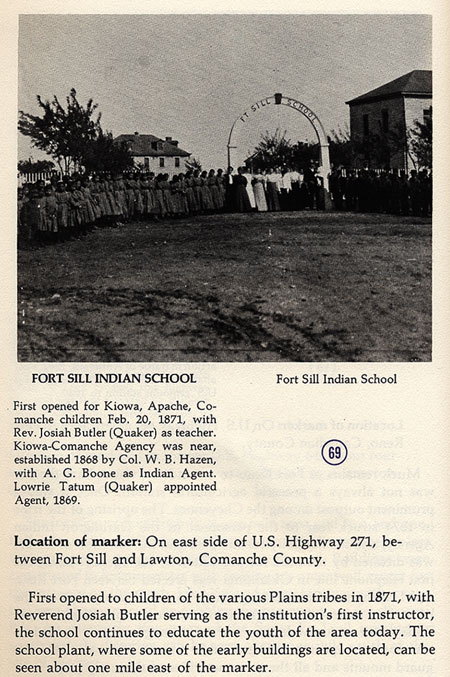
The above information is from the book, Mark of Heritage, by Muriel H. Wright, courtesy of Oklahoma Historical Society. History
The site of Fort Sill was staked out on January 8, 1869 by Maj. Gen.
Philip H. Sheridan who led a Campaign into Indian Territory to stop
hostile tribes from raiding border settlements in Texas Kansas.
Sheridan's massive winter campaign involved six cavalry regiments accompanied
by frontier scouts such as"Buffalo Bill" Cody, "Wild
Bill" Hickok, Ben Clark and Jack Stilwell. Troops camped at the
location of the new fort included the 7th Cavalry, the 19th Kansas Volunteers
and the 10th Cavalry, a distinguished of black "buffalo soldiers" who constructed many of the stone buildings still surrounding the old
post quadrangle.
At first the garrison was called Camp Wichita and referred to by the
Indians as "the Soldier House at Medicine Bluffs." Sheridan
later named it in honor of his West Point classmate and friend, Brig.
Gen. Joshua W. Sill, who was killed during the Civil War. The first
post commander was Brevet Maj. Gen. Benjamin Grierson and the first
Indian agent was Colonel Albert Gallatin Boone, grandson of Daniel Boone.
Several months after the establishment of Fort Sill, President Grant
approved a peace policy placing responsibility for the Southwest tribes
under Quaker Indian agents. Fort Sill soldiers were restricted from
taking punitive action against the Indians who interpreted this as a
sign of weakness. They resumed raiding the Texas frontier and used Fort
Sill as a sanctuary. In 1871 General of the Army William Tecumseh Sherman
arrived at Fort Sill to find several Kiowa chiefs boasting about a wagon
train massacre. When Sherman ordered their arrest during a meeting on
Grierson's porch two of the Indians attempted to assassinate him. In
memory of the event, the Commanding General's quarters were dubbed Sherman
House.
In June 1874 the Comanches, Kiowas and Southern Cheyennes went on the
warpath and the South Plains shook with the hoofbeats of Indian raiders.
The resulting Red River Campaign, which lasted a year, was a war of
attrition involving relentless pursuit by converging military columns.
Without a chance to graze their livestock and faced with a disappearance
of the great buffalo herds, the hostile tribes eventually surrendered.
Quanah Parker and his Quohada Comanches were the last to abandon the
struggle and their arrival at Fort Sill in June 1875 marked the end
of Indian warfare on the south Plains.
Until the territory opened for settlement, Fort Sill's mission was
one of law enforcement and soldiers protected the Indians from outlaws,
squatters and cattle rustlers.
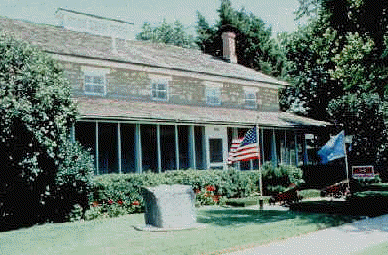
Sherman House, Picture from the Fort Sill National Historic Landmark And Museum Web Site
Above is the site of the exciting showdown where Sherman arrested the Kiowa chiefs responsible for the Warren Wagon Train massacre.
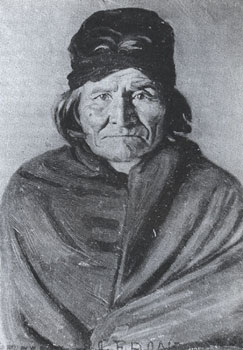
Geronimo. From a portrait by E.A. Burbank.
In 1894 Geronimo and 341 other Apache prisoners of war were brought
to Fort Sill where they lived in villages on the range. Geronimo was
granted permission to travel for a while with Pawnee Bill's Wild West
Show and he visited President Theodore Roosevelt before dying here of
pneumonia in 1909. The rest of the Apaches remained on Fort Sill until
1913 and they were taught by Lt. Hugh L. Scott to build houses, raise
crops and herd cattle.
Scott also commanded troop L of the 7th Cavalry, a unit comprised entirely
of Indians and considered one of the best in the west. Indian scout
I-See-O and other members of the troop are credited with helping tribes
on the South Plains to Avert the Bloody Ghost Dance uprising of the
1890s in which many died on the North Plains.
The last Indian lands in Oklahoma opened for settlement in 1901 and
29,000 homesteaders registered at Fort Sill during July for the land
lottery. On August 6 the town of Lawton sprang up and quickly grew to
become the third largest city in Oklahoma.
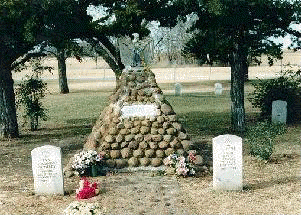
Geronimo's Grave, picture from the Fort Sill National Historic Landmark And Museum Web Site
With the disappearance of the frontier, the mission of Fort Sill gradually
changed from cavalry to field artillery. The first artillery battery
arrived at Fort Sill in 1902 and the last cavalry regiment departed
in May 1907.
The School of Fire for the Field Artillery was founded at Fort Sill
in 1911 and continues to operate today as the world renowned U.S. Army
Field Artillery School. At various times, Fort Sill has also served
as home to the Infantry school of Musketry, the School for Aerial Observers,
the Air Service Flying School, and the Army Aviation School.
Today as the U.S. Army Field Artillery Center, Fort Sill remains the
only active Army installation of all the forts on the South Plains built
during the Indian wars. It serves as a national historic landmark and
home of the Field Artillery for the free world.
Communities and Related Links
|